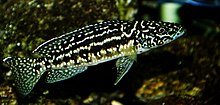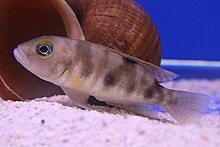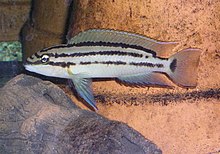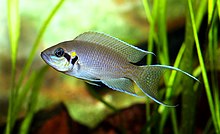Lamprologini
| Lamprologini | ||||||||||||
|---|---|---|---|---|---|---|---|---|---|---|---|---|

Tanganyika snailfish ( Lamprologus ocellatus ) |
||||||||||||
| Systematics | ||||||||||||
|
||||||||||||
| Scientific name | ||||||||||||
| Lamprologini | ||||||||||||
| Poll , 1986 |
The Lamprologini are a tribe of the cichlids (Cichlidae). The vast majority of the almost 100 species of Lamprologini live endemically in Lake Tanganyika and have colonized a wide variety of ecological niches there, but above all rocky habitats. They make up about 40% of the cichlid species there. Nine species of the genus Lamprologus live in the Congo river basin , Neolamprologus devosi in Malagarasi . Unlike the majority of East African cichlids, they are not mouthbrooders, but substrate breeders and lay their eggs in caves and in crevices.
features
The Lamprologini are a very variable cichlid tribe. In most cases the body is more or less elongated and of a brownish, yellowish, black or bluish color, sometimes a combination of several of these colors. Black or dark are usually vertical or horizontal stripes, the unpaired fins and the lower eye area are bluish. The scales are comb scales . In a longitudinal row on the sides of the body (from the rear edge of the gill cover to the caudal fin) there are 33 to 85 scales. The scales on the chest are usually smaller. They can also be absent there. The sideline is usually split in two. The teeth are conical, four to eight enlarged fangs are often visible even when the mouth is closed. The dorsal fin has 17 to 25 spine rays, the anal fin three to ten. In contrast to the often brightly colored mouthbrooders from Lake Malawi and Lake Victoria, the lamprologini are in most cases more plainly colored and males and females do not show any dichromatism, ie they have the same coloration.
Genera
Eight genera currently belong to the tribe Lamprologini:
- Altolamprologus Poll, 1986, (2 species)
- Chalinochromis Poll, 1974, (3 species)
- Julidochromis Boulenger, 1898, (6 species)
- Lamprologus Schilthuis, 1891, (20 species)
- Lepidiolamprologus Pellegrin, 1904, (11 species)
- Neolamprologus Colombe & Allgayer, 1985, (46 species)
- Telmatochromis Boulenger, 1898, (6 species)
- Variabilichromis Colombe & Allgayer, 1985, (1 species)
Most of these genera, however, are not closed communities of descent and for various reasons are para- or polyphyletic . The small Julidochromis species are more closely related to Chalinochromis than to the large Julidochromis species and the large Julidochromis species are more closely related to Neolamprologus walteri than to the small Julidochromis species. The genus Julidochromis is therefore polyphyletic, the genus Chalinochromis is therefore paraphyletic. The characteristic phenotype of the genus Julidochromis probably arose twice in the course of a convergent evolution . Other non-monophyletic genera are Lamprologus, Neolamprologus and Telmatochromis .
Internal system
Based on a comparison of the mitochondrial DNA , twelve clades were identified, some of which can be further divided into subclades. They could become separate genres in the future and are listed below. The listing of some species in two different clades is likely due to hybridizations .
- Clade I.
- 1st subclade
- Neolamprologus cylindricus Staeck & Seegers, 1986
- Neolamprologus mustax (Poll, 1978)
- Neolamprologus nigriventris Büscher, 1992
- 2nd subclade
- Neolamprologus gracilis (Brichard, 1989)
- Neolamprologus marunguensis Büscher, 1989
- Neolamprologus niger (Poll, 1956)
- Neolamprologus olivaceous (Brichard, 1989)
- Neolamprologus savoryi (Poll, 1949)
- 1st subclade
- Clade II (ossified group, the members of this group have ossified lip cartilage), the generic name Stiassnia has been proposed for this group .
- Neolamprologus similis Büscher, 1992
- 1st subclade
- Lamprologus kungweensis Poll, 1956
- Lamprologus laparogramma Bills & Ribbink, 1997
- Lamprologus ornatipinnis Poll, 1949
- Lamprologus signatus Poll, 1952
- 2nd subclade
- Neolamprologus brevis ( Boulenger , 1899)
- Neolamprologus calliurus (Boulenger 1906)
- Lamprologus speciosus Büscher, 1991
- 3rd subclade
- Neolamprologus multifasciatus (Boulenger, 1906)
- 4th subclade
- Neolamprologus leloupi (Poll, 1948)
- 5th subclade
- Neolamprologus caudopunctatus (Poll, 1978)
- Lamprologus lemairii Boulenger, 1899
- 6th subclade
- Lamprologus meleagris Büscher, 1991
- 7th subclade
- Lepidiolamprologus kendalli (Poll & Stewart, 1977)
- 8th subclade
- Altolamprologus
- Lamprologus callipterus Boulenger, 1906
- Lamprologus ocellatus (Steindachner, 1909)
- Neolamprologus fasciatus (Boulenger, 1898)
- 9th subclade (two-pore group)
- Lepidiolamprologus attenuatus (Steindachner, 1909)
- Lepidiolamprologus boulengeri ( Steindachner , 1909)
- Lepidiolamprologus elongatus (Boulenger, 1898), type species of the genus Lepidiolamprologus
- Lepidiolamprologus hecqui (Boulenger, 1899)
- Lepidiolamprologus kendalli (Poll & Stewart, 1977)
- Lepidiolamprologus meeli (Poll, 1948)
- Lepidiolamprologus profundicola (Poll, 1949)
- Lepidiolamprologus variostigma Büscher, 1995
- Clade III
- Neolamprologus sexfasciatus (Trewavas & Poll, 1952)
- Neolamprologus tretocephalus (Boulenger, 1899)
- Clade IV
- Neolamprologus toae (Poll, 1949)
- Clade V
- Variabilichromis moorii (Boulenger, 1898)
- Clade VI
- Neolamprologus leleupi (Poll, 1956)
- Neolamprologus longior (Staeck, 1980)
- Neolamprologus obscurus ( Poll , 1978)
- Neolamprologus prochilus (Bailey & Stewart, 1977)
- Clade VII
- Neolamprologus buescheri (Staeck, 1983)
- Note VIII
- Lepidiolamprologus cunningtoni (Boulenger, 1906)
- Neolamprologus modestus (Boulenger, 1898)
- Neolamprologus tetracanthus (Boulenger, 1899), type species of the genus Neolamprologus
- Clade IX
- Neolamprologus furcifer (Boulenger, 1898)
- Klade X
- Neolamprologus christyi ( Trewavas & Poll , 1952)
- Note XI
- Chalinochromis brichardi Poll, 1974
- Chalinochromis cyanophleps Kullander, Karlsson, Karlsson & Norén, 2014
- Chalinochromis popeleni Brichard, 1989
- Julidochromis dickfeldi Staeck, 1975
- Julidochromis ornatus Boulgenger, 1898, type species of the genus Julidochromis
- Julidochromis transcriptus Matthes, 1959
- Note XII
- 1st subclade
- Neolamprologus falcicula (Brichard, 1989)
- 2nd subclade
- Lamprologus congoensis Schilthuis, 1891, Congo, type species of the genus Lamprologus
- Lamprologus teugelsi Schelly & Stiassny, 2004, Congo
- Neolamprologus devosi Schelly, Stiassny & Seegers, 2003, Malagarasi
- Neolamprologus mondabu (Boulenger, 1906)
- Telmatochromis temporalis Boulenger, 1898
- Telmatochromis vittatus Boulenger, 1898
- 3rd subclade, (brood care helper species, with the members of this group, older young animals remaining in the area help the parents in rearing the youngest)
- Neolamprologus gracilis II
- Neolamprologus helianthus Büscher, 1997
- Neolamprologus marunguensis II
- Neolamprologus pulcher (Trewavas & Poll, 1952)
- Neolamprologus splendens (Brichard, 1989)
- 4th subclade
- Julidochromis marlieri Poll, 1956
- Julidochromis regani Poll, 1942
- Neolamprologus walteri Verburg & Bills, 2007
- 5th subclade
- Neolamprologus savoryi II
- Telmatochromis bifrenatus Myers, 1936
- Telmatochromis dhonti (Boulenger, 1919)
- Telmatochromis temporalis Boulenger, 1898, type species of the genus Telmatochromis
- 1st subclade
External system
Sister group of the Lamprologini is the tribe Ectodini ; the cichlids of this group live endemically in Lake Tanganyika, but not in rocky habitats, but on and over sandy soils. The Ectodini species are mouthbrooders .
literature
- Christian Sturmbauer, Walter Salzburger, Nina Duftner, Robert Schelly, Stephan Koblmüller: Evolutionary history of the Lake Tanganyika cichlid tribe Lamprologini (Teleostei: Perciformes) derived from mitochondrial and nuclear DNA data. Molecular Phylogenetics and Evolution 57 (2010) 266-284, doi: 10.1016 / j.ympev.2010.06.018
Individual evidence
- ↑ Sturmbauer et al. (2010), page 266.
- ^ A b Julia Day, Simona Santini, Jaime Garcia Moreno: Phylogenetic relationships of the Lake Tanganyika cichlid tribe Lamprologini: The story from mitochondrial DNA. Molecular Phylogenetics and Evolution 45 (2): 629-42 December 2007 DOI: 10.1016 / j.ympev.2007.02.025
- ^ Mark Smith: Lake Tanganyika Cichlids. Page 10, Barron's Educational Series, 1998, ISBN 0764106155 Google Books
- ↑ Sturmbauer et al. (2010), page 267.
- ↑ Sturmbauer et al. (2010), page 276.
- ↑ Sturmbauer et al. (2010), page 269.












